|
|
Stockwell

|
|
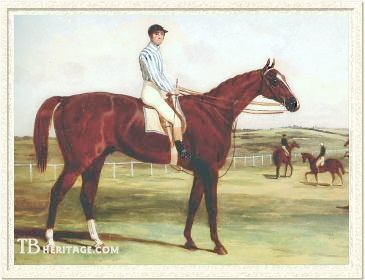 |
|
|
Stockwell was an influential nineteenth century stallion whose sire sons are largely responsible for perpetuating the Eclipse sire line into the present. Called "The Emperor of Stallions" in his own time, having dominated the sire list in England in the 1860s, subsequent generations in tail-male descent have only confirmed the appropriateness of the title, for the early twentieth century stallion, Phalaris, descends in direct male line from him, and consequently so do such influential stallions as Northern Dancer and Nasrullah and all their sons and grandsons.
Stockwell was born at the Stockwell (near Clapham), Surrey, stud farm of John Theobald, in 1849, and was named after that place. The aging Theobald -- in his eighties when Stockwell was foaled -- "and many other good judges" considered him "to be on too large a scale" as a youngster, but Theobald's stud groom, John Lowry, brought him to the attention of Brownlow Cecil, 2nd Marquess of Exeter. Exeter was a prominent member of the Jockey Club, who had been racing horses for over thirty years. Exeter had had six classic winners, including the great race mare Galata, winner of both the One Thousand Guineas and the Oaks in 1832, but he hadn't owned a truly top race horse since her retirement from the turf. Exeter also thought Stockwell "over-large," but purchased him, as a yearling, for 180 sovereigns, with a contingency of £500 more if Stockwell should win the Derby. Thus, Stockwell was sold privately and sent to Exeter's stud farm at Newmarket.
Stockwell grew to be a large horse, over 16 hands in height, and, in the words of one turf writer, "the very incarnation of ugliness." He was plain-headed, with more than a hint of a Roman nose (derived from his sire, The Baron), had tied-in shoulders, and a hind end that was likened to that of a cart horse's. However, his legs had excellent bone and he had good feet, and that cart horse hind-end proved to be a powerful motor that made him a good race horse and an excellent weight-carrier. His way of going was, by all accounts, poor in its action, but it did not prevent him from being one of the fastest horses on the turf in his time. He was a golden chesnut as a younger horse, but the color deepened as he aged, and he had some dark spots in his coat now called "Bend Or Spots," after his grandson, who also displayed them.
Stockwell was not, according to a groom who knew him in his last eight years, "...blessed with the best of tempers; indeed, he was a bit of a savage." He inherited his temper from his sire, "the slim and savage" The Baron (1842), whom Theobald had purchased after his retirement from the turf.
|
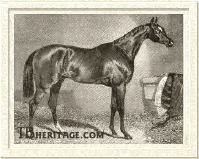
The "Slim and Savage" The Baron
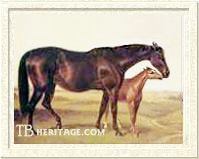
Pocahontas with Stockwell at foot
| |
The Baron was a dark chestnut horse that had been bred in Ireland by English-born George Watts, who was a veterinary surgeon in Dublin and parlayed his connections into a reputation as a breeder of racehorses. He was by the speedy Irish Birdcatcher and out of the Economist mare, Echidna (1838, Family 24), who also produced several fair racing daughter in Ireland. After some wins at age three in Ireland, including the Madrid, Kirwan, and Waterford Stakes, he was shipped to England to race in mid-1845, and after a poor showing in the Liverpool St. Leger, was schooled by the trainer John Scott to win the Doncaster St. Leger, followed by a big win in the two mile Cesarewitch Stakes. He did not win again in several outings in 1846, and, suffering from bad feet, was sold to Theobald. After Theobald's death he was sold on to France, where got three winners of the French Oaks, including the great race filly La Toucques (1860), who also won the French St. Leger, the Prix du Jockey-Club, and the Grosser Preis von Baden-Baden.
Stockwell's dam was the roarer, Pocahontas (1837), out of Marpessa, also a roarer, and by Glencoe, a 2,000 Guineas winner who could stay to win the 2-1/2 mile Ascot Gold Cup. Pocahontas also had a reputation for temper, having "cut up very badly in the Oaks of her year, for which she had been a favorite." She had been purchased by Theobald for his stud, and Stockwell was her fifth foal. Her next foal, Stockwell's brother, Rataplan also became an influential sire, as did her 1851 colt by Harkaway, King Tom, who led the sires list twice. Pocahontas passed on her roaring defect to at least three of her foals, and although her three famous sons never made a sound, it's clear that Stockwell transmitted this trait to some of his offspring and descendants.
|
Stockwell on the Turf
Stockwell ran between the ages of two and five, and was considered both fast and powerful by turf observers. Ungainly at the age of two, and never a particularly good mover, he wasn't started until the fall of that year, in the care of William Harlock at Newmarket. He ran twice, failing by a head to win in the Prendergast Stakes for two year olds, and then running fourth in Newmarket's important juvenile Criterion Stakes over six furlongs, which at that time was run on Cambridge Hill; the youngster placing third, just ahead of him, in the latter race was the small Daniel O'Rourke, who he would meet again in the classics.
Stockwell's three year old year was his best, establishing his credentials as a good racehorse and ensuring he would later attract a nice book of mares. He began at the Newmarket Craven meet by placing second by a neck in a handicap race of three horses, all of an age. His next race was the Two Thousand Guineas Stakes at Newmarket which he won easily by a length in a surprise upset, having been ranked at 10 to 1 odds, with four other horses more favored to win; in this field Daniel O'Rourke, one of the favorites, ran unplaced. He followed this up with a win in the Newmarket Stakes, beating Maidstone, who had bested him in the Prendergast Stakes, and Father Thames, winner of the Newmarket Handicap, and three others.
Then came the Epsom Derby in which he ran eighth in heavy going. His previous wins had not impressed the betting public, and he went off at odds of 16 to 1, well behind the more favored well-tried Little Harry and others. Daniel O'Rourke won this Derby. Some later turf commentators said Stockwell had had a gumboil lanced just prior to the race, which affected his running. Whatever the reason for this loss, he overcame it in a decisive manner, since he ran unbeaten --including two walk-overs -- in eight successive races in the rest of the season. He beat the Touchstone colt Harbinger by a half length in a sweepstakes at Goodwood. This was followed by a walk over for a sweepstakes, and then a two-length win over Maidenstone, Father Thames and others in the Racing Stakes handicap, carrying the heaviest weight. He then won the Great Yorkshire Stakes by a length over Longbow, Hex and nine others, and this was followed by a ten-length win over Harbinger, Daniel O'Rourke, Oaks winner Songstress, and two others in his second classic win, the Doncaster St. Leger. His last three races included a walk-over for the Foal Stakes; a three-length victory "in a canter" in the Grand Duke Michael Stakes, beating the Cesarewitch winner Muscovite; and an easy two-length win in the Newmarket St. Leger.
|
|
Stockwell's Race Record
|
| Year |
Age |
Starts |
1st |
2nd |
3rd |
Unplaced |
| 1851 |
2 |
2 |
0 |
1 |
0 |
1 |
| 1852 |
3 |
12 |
10 |
1 |
0 |
1 |
| 1853 |
4 |
1 |
1 |
0 |
0 |
0 |
| 1854 |
5 |
1 |
1 |
0 |
0 |
0 |
| Total |
-- |
16 |
12 |
2 |
0 |
2 |
| |
In 1853, age 4, Stockwell ran once, placing second by a head for the Emperor of Russia's Plate (Ascot Gold Cup) at Ascot, which was won by game 1851 Derby winner Teddington, who gave Stockwell 9 pounds. Stockwell went "amiss" after that race, and did not run the rest of the year, nor did he run in 1854 until the end of the season.
|
In the fall of 1854 at Newmarket, Exeter challenged for the Whip, and Stockwell ran against Kingston, who broke down during the running, Stockwell romping in thirty lengths ahead of his disabled challenger. After the race Stockwell was retired to the stud, a good, but not great racehorse. The greatness was to come during his stud career.
Stockwell in the Stud
Probably the greatest testament to Stockwell's influence in the stud is the fact that the bulk of graded stakes winners, and consequently successful sires, in the world today trace back to him in tail-male descent, primarily through his grandson, Bend Or, and, in modern times through his distant male line descendant Phalaris. Well over 70 percent of stakes winning horses in the late 1990s descend in tail-male from Phalaris (1913) through Northern Dancer, Nasrullah, Turn-To, and Raise a Native.
Stockwell had a successful run as a stallion, from 1855 until his death in a breeding shed accident in 1870 at age 21. Somewhere along the way he was given the sobriquet "Emperor of Stallions," and from the statistics, it appears a well-earned title: he topped the sires lists in England seven times, 1860 -1862, 1864-67, and was second four times, 1863, 1865-1868, 1872-73. His offspring won a total of 1,150 races, valued then at £362,451. Of his 412 living foals, 208 were winners. His youngsters tended to mature early and he had a significant number of two year old winners in each crop. Twelve of his youngsters together won seventeen classic races, and thirteen others placed in one or more of them. He got a number of successful sire sons that bred on for a number of generations, but it was through St. Albans, paternal antecedent of Rock Sand, imported into the U.S., and more importantly, Doncaster, sire of Bend Or, that the line flourished into the early twentieth century, and then, in the latter case, wildly beyond. Stockwell was also a good broodmare sire, although there his influence on the breed is, in comparison, significantly less. |
|
Stockwell's Classic Youngsters
|
| Year |
Name |
Classic Races Won |
Classic Races Placed |
| 1860 |
St. Albans, ch. c. out of Bribery |
St. Leger |
|
| 1861 |
Caller Ou, br.f. out of Haricot |
St. Leger |
|
| 1861 |
Lady Ripon, ch. f. out of Mary Aislabie |
|
2nd Oaks |
| 1862 |
The Marquis, b.c. out of Cinizelli |
St. Leger, 2,000 Guineas |
|
| 1862 |
Caterer, c. out of Selina |
|
2nd 2,000 Guineas |
| 1862 |
Knowsley, b.c. out of Orlando mare |
|
tied 3rd 2,000 Guineas |
| 1862 |
Bertha, f. out of Princess |
|
2nd 1,000 Guineas |
| 1863 |
Lady Augusta, ch. f. out of Meanee |
1,000 Guineas |
|
| 1864 |
Blair Athol, ch. c. out of Blink Bonny |
Derby, St. Leger |
|
| 1864 |
Tooi Tooi, ch. f. out of Cypriana |
|
3rd 1,000 Guineas |
| 1864 |
Historian br. c. out of Alma |
|
3rd 2,000 Guineas |
| 1865 |
Regalia, ch. f. out of The Gem |
Oaks |
2nd St. Leger |
| 1866 |
Lord Lyon, b.c. out of Paradigm |
Derby, St. Leger, 2,000 Guineas |
|
| 1866 |
Repulse, b.f. out of Sortie |
1,000 Guineas |
|
| 1866 |
Monarch of the Glen, c. out of Glengowrie |
|
2nd 2,000 Guineas |
| 1866 |
Savernake, ch. c. out of Bribery |
|
2nd Derby, 2nd St. Leger |
| 1866 |
Rustic, ch. c. out of Village Lass |
|
3rd Derby |
| 1867 |
Achievement, br. f. out of Paradigm |
St. Leger, 1,000 Guineas |
Tied 2nd Oaks |
| 1868 |
Athena, ch. f. out of Heroine |
|
2nd 1,000 Guineas, 3rd Oaks |
| 1869 |
Belladrum, c. out of Catherine Hayes |
|
2nd 2,000 Guineas |
| 1871 |
Bothwell, br. c. out of Katherine Logie |
2,000 Guineas |
|
| 1871 |
Noblesse, f. out of Brown Duchess |
|
2nd Oaks, 3rd 1,000 Guineas |
| 1873 |
Gang Forward, ch. c. out of Lady Mary |
2,000 Guineas |
Tied 2nd Derby |
| 1873 |
Doncaster, ch. c. out of Marigold |
Derby |
2nd St. Leger |
| 1873 |
Wild Myrtle, b.f. out of Tight-fit |
|
2nd Oaks |
| Total |
25 |
17 |
19 |
|
Stockwell began his stud career at Lord Exeter's stud at Burghley. At the end of his first season in 1855, he was sent to Tattersall's to be sold, with a reserve of 3,000 guineas; he was purchased by Albert Denison [Conyngham], 1st Baron Londesborough. Lord Londesborough had been the financially insolvent and briefly exiled Lord Albert Conyngham, who had returned to England in triumph upon the death of his uncle, a wealthy London banker. The uncle, Mr. Denison, left his nephew a fortune upon condition of his assuming the surname of Denison. Lord Albert was created Baron Londesborough in 1850, the same year he purchased the ancient Londesborough estate in the East Riding of Yorkshire. Stockwell was dispatched to another Londesborough property in West Riding -- Kirkby Farm at Grimston Park, near Tadcaster, where the great racehorse West Australian (the first English Triple Crown winner of 1853) was already in residence, having been purchased in his last year racing, prior to his 1854 Ascot Gold Cup win, by Londesborough and then retired to the stud.
In 1855, Londesborough, who less than a decade earlier had been in penurious circumstances, now owned several estates, a new title, millions of pounds, arguably one of the best race horses ever to grace the turf (West Australian), and one of the best thoroughbred stallions ever to beget a colt (Stockwell). Kirkby Farm stud was later re-named Stockwell Stud, a name it carries to this day, in honor of the horse who first stood there at a fee of 30 guineas. While at Kirkby, he got his first eight classic winners, although of this group only the three year old colt St. Albans and the filly Caller Ou, in her undistinguished juvenile year, were actually on the turf when Lonsdesborough died in 1860. However, other Stockwell youngsters were doing very well, and by the end of the season, Stockwell was at the head of the sire's list for the first time, with a total of £18,201 in earnings by his youngsters.
The Londesborough stock was sold at a dispersal sale at Kirkby in 1860. West Australian was purchased on behalf of the Duc de Morny for 3,000 guineas, and was shipped off to France, where he eventually joined the stables of Napoleon II. Stockwell was also the subject of de Morny's bidding interest, but at 4,500 guineas he finally went to Richard C. Naylor (1814 - 1899) of Cheshire. Naylor had been a banker in Liverpool who co-inherited a deal of money from his maternal uncle Christopher Leyland of Lancaster in 1848. He purchased Hooton Hall in Cheshire from Sir Massey Stanley that year, and proceded to upgrade the estate and structures there; he served as High Sheriff of Cheshire in 1856, and later, 1872-74 was Master of the Pytchley Hounds. In 1875, five years after Stockwell's death, he sold off the contents of the house, and left the estate, which included a racecourse, with caretaker servants and removed to Northamptonshire. The British government requistioned the estate for a training ground and the hall for a convalescent home during the First World War, and later an airport was built on the site, now partly in commercial development; the stud farm where Stockwell spent his last eight years is now largely located beneath the M53 motorway.
Stockwell was sent to the Rawcliffe Stud near York for the 1861 and 1862 seasons, where on the basis of his increasing strong representation on the turf, his stud fee was raised to 40 guineas, and his (full) book set at 50 mares. At the racetrack his progeny were busy propelling him into his second and third years as Britain's leading sire, and "Everyone," according to a contemporary turf writer, "is trying to get a nomination to Stockwell."
At the end of the 1862 season, Stockwell was transferred to Naylor's own stud farm at Hooton Park, and there he spent the final eight years of his life, with daily fifteen mile walks in good weather with his groom Mat Veal, stopping with him at the various public houses along their regular route so that Veal could refresh himself with a pint of ale. Stockwell's stabling at Hooton consisted of an old large barn "big enough for him to run about in." Inexpensive sheds and boxes for yearlings and mares were erected to accomodate the mares and yearlings of Naylor's and of those lucky enough to get bookings to Stockwell, whose stud fee towards the end of the 1860s was an astronomical 300 guineas. Naylor's own mares produced almost half of the foals gotten by Stockwell at Hooton.
|
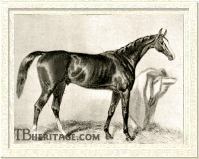
St. Albans
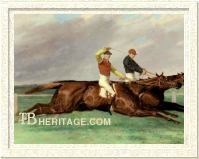
Savernake
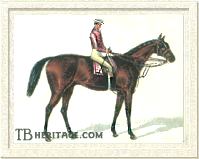
The Marquis
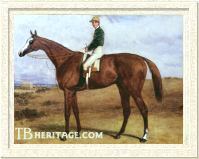
Blair Athol
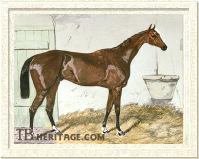
Lord Lyon
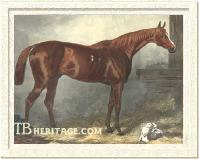
Doncaster 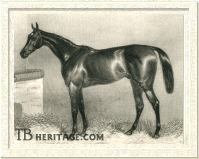
Asteroid
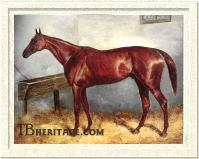
Thunderbolt
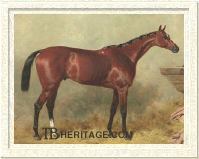
The Duke
| | Stockwell's Sons
Stockwell's first classic winner, who founded a sire line extending into the 20th century, was ST. ALBANS (1857), a flashy dark chestnut with a bad temper and a delicate constitution. He won the Great Metropolitan Stakes, the Newmarket Stakes and the Chester Cup, but was withdrawn from the Epsom Derby, showing signs of unsoundness. He was nursed along until the Doncaster St. Leger, which he won in an exciting race where the leaders, in a very good field that included Thormanby, Sweetsauce, Umpire and Buccaneer (none of whom placed) went early to speed, and he rushed past them towards the end, winning by two lengths. In all, he won five races worth £8,518. In the stud he got Julius, a very good racehorse, and Springfield, a fast sprinter -- unbeaten at ages 3 and 4 -- who could also go 1-1/4 mile, which he did in beating Silvio in the Champion Stakes. It is through Springfield this sire line of Stockwell descends, leading through his sons Watercress (sent to the U.S.) and Epsom Derby winner Sainfoin, who sired the English Triple Crown champion Rock Sand, later imported into the U.S. where he sired Tracery and Mahubah, dam of Man o' War.
St. Albans' dam, Bribery (1851, Family 2), by The Libel, won the Goodwood Stakes and four other races when on the track, and in the breeding shed also produced Lord Ailesbury's SAVERNAKE (1866, by Stockwell), second in both the Derby and the St. Leger (by a head) to LORD LYON. He was sold to the German state stud at Graditz, where he was leading sire in Germany four times.
THE MARQUIS (1859) was out of the Touchstone daughter Cinizelli, who also produced the 1855 Oaks winner Marchioness (by Melbourne). He won both the Two Thousand Guineas and the St. Leger, and was just beaten into second place by Caractacus in the Derby. He won only seven races, but his classic wins brought his total earnings to £11,050. He was later exported to Australia, where he got Newminster (1873), a two-time leading sire there.
BLAIR ATHOL (1861) was a big, rangy chestnut son of the great Melbourne daughter Blink Bonny, who had won the Derby and the Oaks. He won five races, including the Derby, his very first outing, and the St. Leger, and in between was shipped to France where he placed second in the Grand Prix de Paris. He injured a tendon pulling up after the St. Leger and was retired to stud, where he was well-patronized, despite his rising fees. Seemingly Stockwell's best sire son while he lived, he led the sires lists four times in the 1870s, his youngsters noted more for their speed than their staying power. His best son was Silvio, who, like his sire won both the Derby and St. Leger, before being sent to stud duty in France, where he was a leading sire. The Blair Athol line continued for a few generations in the U.S. through the 17 hand Prince Charlie (later sent to the U.S. and sire of Salvator), who despite being a roarer like his great-grandam, ran for four years, winning the Two Thousand Guineas at age 3, and all ten of his races as a four year old. Another son, The Rover, sired the shared-Derby and Ascot Gold Cup winner St. Gatien, whose son, Meddler (1890) was unbeaten as a juvenile and later sent to the U.S. where he was leading sire twice. Blair Athol's best daughter was Paraffin (out of Paradigm), second dam of One Thousand Guineas winner Chelandry and dual classic winner Ladas.
LORD LYON (1863), a sturdy 15-3/4 hand bay, won the English Triple Crown and seventeen other good races from his twenty-one starts, and headed Stockwell's list of earners, having won £26,325. He was out of the amazing producer Paradigm (1852), by Paragone, who also foaled Stockwell's dual-classic winning filly, ACHIEVEMENT, and another Stockwell daughter, CHEVISAUNCE, who produced the classic winning Jannette; when bred to Blair Athol, Paradigm produced Paraffin, who was the ancestress of many classic winners and other top horses (Family 1). Lord Lyon's male progeny carried the line into the 20th century via Minting, winner of the Grand Prix de Paris and other races, but who was overshadowed by his close relative, the great Ormonde. Minting got Ugly, sire of Spanish Prince II (sire of the great American racemare, Princess Doreen), and the good producers Maid of the Mint (dam of Spearmint) and One I Love.
The chestnut Derby winner DONCASTER (1870) only won four races, but they were worth £7,510, which earned him a spot as ninth on Stockwell's list of top winners. He was a good sire who got the Derby champion and top sire Bend Or, through whom the sire line extends and flourishes into the present. He also sired One Thousand Guineas winner Farewell, and other good stakes winners.
Stockwell's other two classic winning sons were BOTHWELL (1868) and GANG FORWARD (1870). The brown Bothwell, who was a roarer, also won the Gimcrack Stakes as a juvenile. He was out of a Flying Dutchman daughter, and had no impact in the stud. The chestnut Gang Forward was a better racehorse, who also won the Jockey Club Cup, the St. James' Palace Stakes and the Ascot Derby, and a total of £7,591 in his ten wins, placing him in the top ten of Stockwell's earners. He was out of the Orlando mare, Lady Mary. In the stud Gang Forward sired some daughters who bred on; he was later sent to Australia.
The bay colt ASTEROID (1858) was another good racing son of Stockwell, from the Touchstone daughter Teetotum. Game, honest, and almost always in the money against top company, he ran for five years, his best win the Ascot Cup at age four. He got some good winners, and a few daughters who bred on.
The richly-colored chestnut THUNDERBOLT (1857), out of Cordelia, by Red Deer, was a good racehorse and weight-carrier who won the Goodwood Stewards' Cup, the Stockbridge Cup, and ten other races in four seasons on the turf. He sired Krakatoa, winner of the Grand St. Leger de France and the Prix du Cadran, and a number of daughters who were good on the turf and in the stud.
THE DUKE (1862), a Goodwood Cup winner, got Colleen Rhue, dam of two Irish Derby winners, Maid of Athens and Kyrle Daly; and Cherry Duchess, dam of July Cup winner Energy, who sired several French classic winners and of Two Thousand Guineas winner Enthusiast. The Duke's son, Bertram, sired Robert the Devil, Bend Or's nemesis on the turf, who continued the line into the future for several generations.
|
Of Stockwell's other sons who bred on, LORD RONALD (1862), from the Newminster daughter, Edith, got the handsome chestnut Master Kildare, unbeaten juvenile in Ireland and good winner in England, including the Epsom's City and Suburban Handicap. Master Kildare, in turn, sired some good producing daughters and Derby winner Melton, who got the American colt Sysonby, called "the horse of the century" in the U.S and some important broodmare daughters. Another Stockwell son and a brother to Blair Athol, BREADALBANE (1862), got The Ill-Used, imported into the U.S., where he got some very good producing daughters; BREADALBANE was purchased at the Middle Park dispersal sale in 1872 for 6,000 guineas by Georg von Lehndorff and sent to Germany, where he was a failure at stud.
The Irish-born UNCAS (1865, out of Nightingale, by Mountain Deer), won all the important Irish stakes for juveniles, making him leading money winner in Ireland in 1867; he went on to win the Triennial at Newmarket that year, and place second in the Ascot Triennial. He was leading sire in Ireland five times -- in 1875, 1877, and 1879-1881, with numerous winners, among them four winners of the Irish Derby.
Stockwell's son CITADEL (1859), a full brother to One Thousand Guineas winner REPULSE, was sent to the U.S., as was his son, Glenelg (in utero); Glenelg was a champion handicap horse and four times leading sire in the U.S., his most notable offspring the champion mares, Firenzi, and Ferida. By getting Clara D., Glenelg is seen in the pedigrees of a great many thoroughbreds today through her son Americus.
Stockwell's Daughters
Stockwell's daughters were as good as his sons on the turf, and two of them, Achievement and Caller Ou, won against the colts in the Doncaster St. Leger; a third, Oaks winner Regalia, placed second in that race. He got five classic winning fillies, and six more were placed in the classics (plus St. Leger winner winner Achievement, who dead-heated for second in the Oaks). His daughters also were good producers of classic winners and other top racehorses in England and abroad: horses such as the Australian great Chester, the influential sire Sundridge, the top race horse Isonomy, and the influential German sire Flibustier, were all from daughters or tail-female to Stockwell daughters.
|
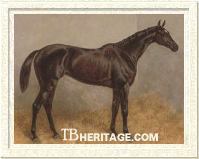
Caller Ou
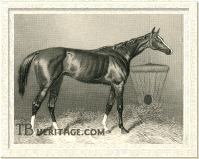
Regalia
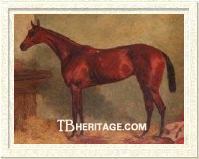
Repulse
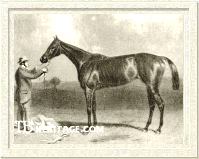
Achievement
| |
Stockwell's Racing Daughters
CALLER OU (1858), from Haricot (second dam of Hampton and Sir Bevys) , was an ewe-necked, hard-pulling mare who showed little promise at age 2, despite good trials, and failed to place at age three in the Oaks. After that, her story changed: she won the St. Leger, beating Derby winner Kettledrum by a head. She went on to run to the age of seven, winning fifty-one of her 101 starts, and was among Stockwell's top ten earners, with a total of £11,014 in winnings in her years on the turf. She produced several daughters that bred on.
The flashy chestnut REGALIA (1862), from the Touchstone daughter The Gem, was also a slow-starter who did not win at two. At age three she won the Oaks by four lengths on a dark rainy day against some good fillies, and went on to place second to Gladiateur in the St. Leger. She ran for four years and won a number of Queen's Plates at various venues, but her best in the more important races was limited to second place, such as her second in the Ascot Cup to Gladiateur in 1866. Sold to go to stud in France, she produced Zut (1876, by Flageolet), winner of the Triple Crown in France--the French 2,000 Guineas, the Grand Prix du Jockey Club and the Prix du Royal Oak -- and Verneuil (1874, by Mortemer), who won the Ascot Gold Cup, as well as some good daughters who bred on in France, and later South America.
The bay filly REPULSE (1863) was from a Melbourne mare, Sortie, who was also the dam of the Stockwell colt, Citadel, sire of Glenelg. She won a couple of races at age two, and was ready at age three to win the One Thousand Guineas against a field of nine. She was then purchased by the Marquess of Hastings, who was later inextricably linked with Hermit's story, and failed to win, or even place in a number of engagements; resold to her previous owner and breeder, John Jackson, she ran for one more year, winning the Richmond Cup and the Zetland Plate. Some of her daughters bred on.
ACHIEVEMENT (1864) was a big dark-brown filly, 15.3 hands, with the somewhat unattractive Stockwell head, built light and narrow, but with a deep girth and strong gaskin. She was a full sister to Stockwell's Triple Crown winner, LORD LYON, and to CHEVISAUNCE, who produced Oaks and St. Leger winner Jannette. Achievement was a top race filly, probably the best juvenile of her generation, who at three won the One Thousand Guineas and the St. Leger, and dead-heated for second in the Oaks to Hippia. She won a number of other races at age three, including the Coronation Stakes and the Great Yorkshire Stakes. She was second, behind LORD LYON, as Stockwell's best earner, having won a total of £22,442 in her 16 wins. She died before she could produce a foal.
|
ATHENA (1865), from Heroine, was another exceptional race filly, Stockwell's fourth highest earner on the turf, with a total of £11,660 in winnings of 18 races. She was a very good juvenile who won £5,860 that season for her purchaser, the Marquess of Hastings. At age three she won six more races, worth £5,665, placing second in the One Thousand Guineas and third in the Oaks. She had no listed produce.
Stockwell's Daughters as Broodmares
A handful of Stockwell's daughters produced classic winners in England, and others, sent abroad, produced classic winners in their new homes. Many of the dams of these mares, as might be expected from the limited books Stockwell entertained, were from top families.
ANONYMA (1859), bred to Hermit, produced the Oaks winner Lonely (1882). DEVOTION (1869), also bred to Hermit, produced the top race filly Thebais (1878), who won the One Thousand Guineas, the Epsom Oaks, the Yorkshire Oaks and other good races, and her sister, St. Marguerite (1879), who won the One Thousand Guineas and ran second in the Oaks. St. Marguerite later produced the St. Simon filly Roquebrune, who was dam of the English Triple Crown champion Rock Sand, who as a son of Sainfoin, was in-bred to Stockwell.
CANTINIERE (1870) was the dam of the good filly Dutch Oven (1879), by Dutch Skater; Dutch Oven was a top juvenile and went on to win the Doncaster St. Leger easily at age three. Another outstanding race filly, Jannette (1875), by Newminster son Lord Clifden, was out of Stockwell's daughter CHEVISAUNCE (1868). Jannette won the Epsom Oaks, the Doncaster St. Leger, the Jockey Club Cup, and many other top races. Yet another good Stockwell grandaughter was Belphoebe (1874), by Toxophile, out of VAGA (1858); she won the One Thousand Guineas and the Coronation Stakes, among other races.
MUSIC (1866) produced Ossian (1880), by Salvator, who won the St. Leger and the Great Yorkshire Stakes, among other races. Another Stockwell grandson, George Frederick (1871), by Marsyas, from PRINCESS OF WALES (1862), won the Derby. And finally, VAS BLEU produced Derby and Ascot Gold Cup winner Blue Gown (1865), by Beadsman.
Other good-producing Stockwell daughters included ISOLA BELLA (1868), dam of the good stayer and later sire, Isonomy (1875), who won the Cambridgeshire, Ascot Gold Cup and Ascot Gold Vase, among other important races, and his brother Fernandez, who won the Craven Stakes.
Flibustier (1867), winner of the Union Rennen in Germany by Buccaneer out of Stockwell daughter SWEET KATIE (1861) was an important sire in Germany who got Trachenberg (1879) and Kunsterlin (1876), both winners of the Deutsches Derby, and who was a very good broodmare sire whose daughters produced classic winners in Germany.
Tristan (1878), by Hermit from Stockwell's daughter THRIFT (1865), was the amazing three-time winner of the Champion Stakes and the Hardwicke Stakes in England, and of the Grand Prix de Deauville in France, as well as the Ascot Gold Cup and other top races. He is primarily known today as the sire of Canterbury Pilgrim, dam of leading sires Chaucer and Swynford.
Kilt (1873), was out of HIGHLAND SISTER (1864) and by Consul. He won the Grand Prix du Jockey Club (French Derby) and Prix du Royal Oak (French St. Leger) in France. Other good French grandsons of Stockwell included Stuart (1885) from STOCKHAUSEN, who won the Grand Prix de Paris and the Grand Prix du Jockey Club, and Bruce (1879), from CARINE, who was another Grand Prix de Paris winner.
Chester (1874), by the top Australian sire Yattendon was from the imported Stockwell daughter LADY CHESTER. He was a winner of many good races in Australia, including the Melbourne Cup. In the stud he was was a great success, who got four winners of the Australian Jockey Club Oaks, four winners of the Australian Jockey Club Derby, and three winners of the Australian Jockey Club St. Leger.
SANDAL (1861) was the second dam of Derby winner Sainfoin (1887), by Springfield, and of Sierra (1889) who was dam of the influential sire Sundridge and his sister Amphora. LADY HIGHTHORN (1865) was second dam of One Thousand Guineas winner Siffleuse (1890). In the third remove, LADY BLANCHE (1856) is seen in the tail-female pedigree of 2,000 Guineas and Grand Prix de Paris winner Paradox (1882). WOODBINE (1860), was third dam in tail-female descent of Derby and St. Leger winner, and later sire, Melton (1882), who was also a great-grandson of Stockwell's through Lord Ronald; she has her own branch of Family 8.
Stockwell died on May 5, 1870, when, rearing as he was brought into the covering yard, he fell over backwards on his tail, breaking his spine in four places and piercing his rectum; he got up and proceded to cover the mare, his last. Nine days later, pacing his box stall in pain, "...he gave a loud neigh and dropped to the ground dead." It was, a Hooton employee later said, "the gamest death I ever saw." Buried before his vacationing owner could return home, he was later exhumed and his skeleton was sent to the British Museum in London.
--Patricia Erigero
|
|
|
|

